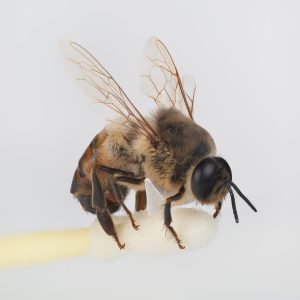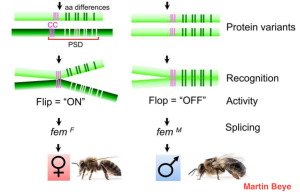Click Here if you listened. We’d love to know what you think. There is even a spot for feedback!
Read along below!
Found in Translation
An Egg-Level View of Drone Production
By: Jay Evans, USDA Beltsville Bee Lab
Honey bee males, or drones, are belittled but key members of the colony. They also form a test case for one of the most fundamental questions in animals and plants. When there is a distinction between males and females, how does that come about? In bees, as in many other species, development into males or females is not black and white. There are proteins (or in cases like our own species, entire chromosomes) that help set the stage for a cascade of events that determines sex. Most of the time, a single trigger, or ‘sex-determining factor’, starts the male and female cascades, and these cascades generally result in physically different males and females. Both that trigger and the resulting cascade differ across the tree of life, and it is hard to point to common sex-determining factors across the insects, let alone the cascades that generate distinct males and females more generally. Thus, it was a really big deal 20 years ago when a research group in Germany led by Martin Beye won the race to find a plausible sex-determining factor for honey bees (M. Beye, M. Hasselmann, M. K. Fondrk, R. E. Page, S.W. Omholt, 2003. The gene csd is the primary signal for sexual development in the honey bee and encodes an SR-type protein Cell 114, 419–429, https://doi.org/10.1016/S0092-8674(03)00606-8). Just this month, that same group closed the circle by demonstrating the key mechanisms by which this factor kicks off drone versus female production in bees… but first some background.
 It is staggering to realize that a European priest, Johann Dzierzon, accurately described the process that leads to male honey bees 180 years ago. He was able to show, experimentally, that queens which had been prevented from mating were exclusively drone layers. Genes were not a thing then, let alone sex-determining genes, but genetics was soon to be a field, and there is evidence that Dzierzon’s insights and experiments helped trigger the appreciation for how genetic variation leads to the diversity we see within species. Dzierzon’s passions included how worker bee body colors reflected both queens and their mates and his careful work likely planted seeds in the mind of fellow priest and apiarist Gregor Mendel, who was starting to conduct the pea breeding experiments that defined his own legacy. A nice recent review by Gene Kritsky builds the case for Mendel’s likely exposure to Dzierzon’s thinking in science circles of the 1850’s and 60’s (Kritsky, G. Bees and Peas: How apiology influenced Gregor Mendel’s research. 2023. American Entomologist, 69, 40-45, doi:10.1093/ae/tmad025). Mendel did not formally acknowledge the assist, and it is unclear whether he would have reached the same conclusions and experiments solo. What is certain is that Dzierzon got pretty much everything correct about honey bee reproduction, marveling at queen nuptial flights and the abilities of queens to take or leave sperm from those flights as they nurtured their developing eggs, “The power of the fertile queen, accordingly, to lay worker or drone eggs at pleasure is rendered very easy of explanation by the fact that the drone eggs require no impregnation, but bring the germ of life with them out of the ovary; whilst otherwise it would be inexplicable and incredible. Thus the queen has it in her power to deposit an egg just as it comes from the ovary, and as the unfecundated mothers lay it; or by the action of the seminal receptacle, past which it must glide, to invest it with a higher degree, a higher potency, of fertility and awaken in it the germ of a more perfect being, namely a queen or a worker bee.”
It is staggering to realize that a European priest, Johann Dzierzon, accurately described the process that leads to male honey bees 180 years ago. He was able to show, experimentally, that queens which had been prevented from mating were exclusively drone layers. Genes were not a thing then, let alone sex-determining genes, but genetics was soon to be a field, and there is evidence that Dzierzon’s insights and experiments helped trigger the appreciation for how genetic variation leads to the diversity we see within species. Dzierzon’s passions included how worker bee body colors reflected both queens and their mates and his careful work likely planted seeds in the mind of fellow priest and apiarist Gregor Mendel, who was starting to conduct the pea breeding experiments that defined his own legacy. A nice recent review by Gene Kritsky builds the case for Mendel’s likely exposure to Dzierzon’s thinking in science circles of the 1850’s and 60’s (Kritsky, G. Bees and Peas: How apiology influenced Gregor Mendel’s research. 2023. American Entomologist, 69, 40-45, doi:10.1093/ae/tmad025). Mendel did not formally acknowledge the assist, and it is unclear whether he would have reached the same conclusions and experiments solo. What is certain is that Dzierzon got pretty much everything correct about honey bee reproduction, marveling at queen nuptial flights and the abilities of queens to take or leave sperm from those flights as they nurtured their developing eggs, “The power of the fertile queen, accordingly, to lay worker or drone eggs at pleasure is rendered very easy of explanation by the fact that the drone eggs require no impregnation, but bring the germ of life with them out of the ovary; whilst otherwise it would be inexplicable and incredible. Thus the queen has it in her power to deposit an egg just as it comes from the ovary, and as the unfecundated mothers lay it; or by the action of the seminal receptacle, past which it must glide, to invest it with a higher degree, a higher potency, of fertility and awaken in it the germ of a more perfect being, namely a queen or a worker bee.”
 So, how does recent research close the deal for honey bee sex determination? It was evident that the complementary sex determination (csd) gene identified by Beye and colleagues had a highly variable stretch that shows maybe 20 sequence variants in a given population and 100 overall in the species. If diploid female bees are many hundred-fold more frequent than diploid males (which are generally removed by their sisters during development), a gene with this amount of variation fits the bill as the trigger for sex, but how does it all work? Marianne Otte and colleagues from the Beye lab used several genetic tricks to show that a mismatch for this one gene between two chromosomes is both necessary and sufficient to generate female bees. They used ‘CRISPR’ gene editing of fertilized eggs to nullify sections of that variable region. When this happened, bees that would have developed into females were male. They also inserted a polymorphism into drone-layer queens and those queens then produced viable females. Basically, matches for a tiny region of this one protein were sufficient to bind the protein in ways that changed its effects on the next proteins in the cascade and altered the sex of these bees (see graphic). If one of those amino acids was mismatched between the two gene copies, the resulting poor binding led to a female cascade. That’s a simple mechanism for letting a single gene impact sex determination.
So, how does recent research close the deal for honey bee sex determination? It was evident that the complementary sex determination (csd) gene identified by Beye and colleagues had a highly variable stretch that shows maybe 20 sequence variants in a given population and 100 overall in the species. If diploid female bees are many hundred-fold more frequent than diploid males (which are generally removed by their sisters during development), a gene with this amount of variation fits the bill as the trigger for sex, but how does it all work? Marianne Otte and colleagues from the Beye lab used several genetic tricks to show that a mismatch for this one gene between two chromosomes is both necessary and sufficient to generate female bees. They used ‘CRISPR’ gene editing of fertilized eggs to nullify sections of that variable region. When this happened, bees that would have developed into females were male. They also inserted a polymorphism into drone-layer queens and those queens then produced viable females. Basically, matches for a tiny region of this one protein were sufficient to bind the protein in ways that changed its effects on the next proteins in the cascade and altered the sex of these bees (see graphic). If one of those amino acids was mismatched between the two gene copies, the resulting poor binding led to a female cascade. That’s a simple mechanism for letting a single gene impact sex determination.
While csd appears to be unique to certain insects with haploid males (bees, wasps, ants in particular), it shows a historical similarity to ‘transformer’ proteins, which are known as key actors in insects with diploid males and females and sex chromosomes (i.e., with sex determination that is more like our own). How the leap was made from traditional sex chromosomes to species with haploid males is another mystery. In a practical sense, researchers are rapidly determining variation at csd across populations at all sizes. There is a cost to colonies when queens are mated to males with matching csd alleles. Even though many such ‘diploid males’ are purged early in development the initial effort to raise them, and patchy brood patterns, can both weigh colonies down. Knowing the exact mechanism by which variation works at this locus allows for accurate screens of breeding stock and larger commercial apiaries to see where adding fresh genes might improve productivity. It’s also really neat to think that every cell of a worker bee (or queen) in your colony carries a tiny genetic difference at one of the thousands of her proteins that defines her life.







